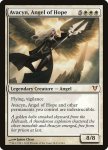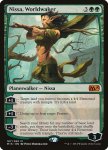An essential part of playing Magic well is learning how to discern which cards are good and which are bad. Magic, as you know if you play, is a complicated game with a lot of cards and a lot of rules, such that he dichotomy of “good” and “bad” is woefully insufficient, and figuring out which cards should make the cut can be a daunting task, and way more can be said about card evaluation than what I’m about to say here. Still, I’d like to share a few helpful hints that I’ve picked up over the years from pro players, podcasts, and articles on various MtG sites.
When evaluating a card, consider the following:
1. Cost: I’m referring to mana cost (though financial cost is worth considering as well, if only to determine whether a given card is worth playing for you). This is a pretty simple category. The cheaper a spell, the better. Like money, one should spend one’s mana wisely, and it’s simply not wise to spend too much mana for a spell that’s simply not worth the cost or the time it takes to cast it. Magic players are all about value. We want to get as much as we can for as cheap as possible. Again, simple.
Comparing mana costs is where it gets a little more complex. Five mana and six mana may seem almost the same, but they are in fact much further from each other than, say, one mana and two mana. The reason is that, in general, it’s much more difficult to go from five mana sources to six in a game of Magic than it is to go from one mana source to two. It’s safe to assume that, in most games, a player can play a land on his or her first and second turn. It’s not so safe to assume that a player can or will be able to play a land for the first six turns in a row. Generally speaking, one’s draws need to be ideal for that to happen. So, the difference between a five mana card and a six mana card isn’t just one extra turn, but possibly two or three extra turns before a player can put that six-drop on the battlefield. Some cards are worth the extra effort of trying to reach six or more mana. Some are not.
2. Context: Nothing exists in a vacuum. This is especially true for Magic cards. Asking, “Is this a good card?” should always be asked with the context of the card in mind; namely, the frame of reference in which the card will be played. The frame of reference (the context) of a card includes the format in which the card might be played, the deck archetype in which the card might see play – or the lack of deck archetype in a given format – and other cards which might be candidates for the role that card might have in a deck.
To offer a couple examples: Nightveil Specter wasn’t given much thought in Standard before devotion came along in Theros. Conversely, a lot of players saw the potential in Fleecemane Lion right away when Theros came out, but, like Nightveil Specter, Fleecemane didn’t quite have the right home for a while. There wasn’t a strong W/G archetype in Standard in which Fleecemane’s abilities could shine. Now it’s a Standard staple in Abzan and G/W variants.
3. Conditions: Cards should be evaluated based on how helpful they can be in various conditions or game states in which a player may find oneself. Those conditions include: winning, losing, and parity. When I consider a card, I ask, “How can this card help me if I’m winning?” Will it help me seal the deal or better my position to lock down the win? “How can this card help me if I’m losing?” Will it help me recover lost ground, or help even the playing field enough to get me back in the game? “How can this card help me if my opponent and I are in a stalemate or board stall?” Can this card give me enough advantage to pull ahead of my opponent?
4. Choices: By “choices” I mean: how many choices or options does this card give me? How many things can I do with this card? If a card can only do one thing, then it better do that one thing extremely well. But most cards can do more than just one thing. For example, the card Swords to Plowshares. It’s been the premium spot removal spell for white for years. On the surface, it looks like it does just one thing. Even if that were true, it would still be a good card, because it does that one thing (i.e., removes a creature) very well, and for as low a mana cost as one can hope. But StP does more than just “exile target creature.” As an instant, it can be part of a combat trick (I attack, my opponent blocks with two creatures, I StP one of them and my creature kills the other via combat damage). Swords to Plowshares’ drawback is that the controller of the exiled creature gains some life. But, if I’m desperately low on life, I can StP one of my own creatures to buy myself some time. I’ve seen it happen, and players pull out wins because they Swords their own creature. So Swords to Plowshares can do at least three things, at instant speed, and all for just one white mana.
To conclude clearly and concisely: card evaluation at its core is concerned with critiquing a card in consideration of its cost and context, contemplating one’s condition in combat by being cognizant of the choices a card contributes.
— Bud
(Lover of Alliteration)




















